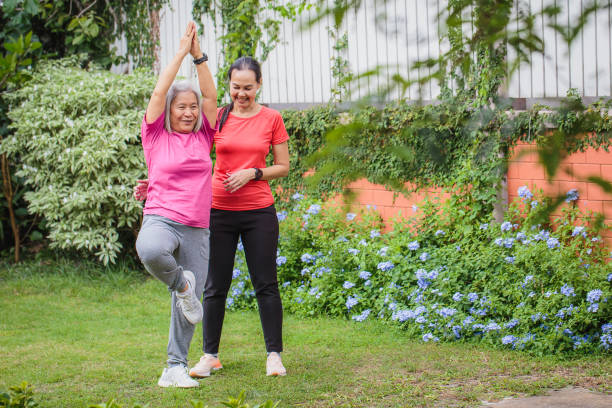The Importance of Balance Exercises for Seniors
Maintaining balance becomes increasingly crucial as individuals age, especially for senior citizens. Engaging in balance exercises can significantly reduce the risk of falls, which is a significant concern for seniors as falls can lead to severe injuries and impact their quality of life. In fact, falls are the leading cause of fatal and nonfatal injuries among older adults, with one in four Americans aged 65 and older falling each year.
Understanding the Risk of Falls
The risk of falls among seniors is multifactorial. Age-related decline in balance systems, such as stiff or damaged joints, neurological conditions, inner ear problems, and decreased muscle mass, can contribute to balance problems. Lack of exercise also plays a role, as it contributes to decreased bone density, muscle mass, and coordination, further increasing the risk of falls.
Symptoms of balance problems in seniors may include stumbling while walking, struggling to stand up unassisted, or experiencing other balance disorder symptoms [3]. If left untreated, these issues can lead to fatigue and depression, impacting overall well-being.
Impact on Quality of Life
The impact of falls on the quality of life for seniors cannot be underestimated. Falls can result in severe injuries, fractures, and head trauma. Recovery from these injuries may be lengthy and challenging, leading to decreased mobility and independence.
By improving balance through regular balance exercises, seniors can reduce the risk of falls and maintain their independence in everyday activities, enhancing their overall quality of life. Balance exercises help in strengthening core muscles, improving stability, and promoting good posture, all of which are essential for preventing falls and maintaining physical health in seniors.
Recognizing the importance of balance for seniors, the Centers for Disease Control and Prevention (CDC) recommends balance exercises as part of a comprehensive program to prevent falls and reduce the risk of fall-related injuries. Incorporating balance exercises into daily routines can have a positive impact on overall well-being, helping seniors maintain mobility, joint health, cognitive function, and independence. It is essential for caregivers and healthcare providers to address balance problems early on to ensure seniors’ safety and well-being.
Understanding the importance of balance exercises for seniors can empower individuals and caregivers to prioritize balance training and incorporate it into their daily routine. By doing so, seniors can enhance their overall physical health, reduce the risk of falls, and maintain their independence for a fulfilling and active lifestyle.
Benefits of Balance Exercises for Seniors
Engaging in balance exercises provides numerous benefits for senior citizens, contributing to their overall well-being and quality of life. These exercises play a crucial role in reducing the risk of falls, maintaining independence and daily activities, improving posture and stability, and enhancing cognitive function.
Reducing the Risk of Falls
Falls are a significant concern for senior citizens, as they can lead to severe injuries and impact their quality of life. Engaging in balance exercises can help reduce this risk by improving stability and coordination. Lack of exercise contributes to decreased bone density, muscle mass, and coordination, which can increase the risk of falls among older adults. By incorporating balance exercises into their routine, seniors can enhance their balance and minimize the risk of falls, allowing them to maintain their independence in everyday activities.
Maintaining Independence and Daily Activities
Good balance is crucial for maintaining body position, walking without staggering, getting up from a chair safely, climbing stairs without tripping, and carrying out daily activities. By improving balance through exercises, seniors can confidently engage in these activities, reducing their reliance on assistance and promoting independence. Engaging in balance exercises helps seniors maintain their ability to perform daily tasks, enhancing their quality of life.
Improving Posture and Stability
Balance exercises play a vital role in strengthening core muscles, improving stability, and promoting good posture. Good posture and stability are essential for preventing falls and maintaining overall physical health in seniors. By incorporating balance exercises into their routine, seniors can improve their posture, reduce muscle imbalances, and enhance their overall stability.
Enhancing Cognitive Function
Engaging in balance exercises not only benefits physical health but also enhances cognitive function in seniors. These exercises require concentration, coordination, and mental focus, stimulating neural connections and improving cognitive abilities. By challenging the brain and body simultaneously, balance exercises can help enhance cognitive function, including memory and attention span.
By understanding the benefits of balance exercises for seniors, it becomes clear why they are an essential component of maintaining a healthy and active lifestyle. These exercises not only reduce the risk of falls but also contribute to maintaining independence, improving posture and stability, and enhancing cognitive function. Incorporating balance exercises into a regular routine can have a profound impact on the overall well-being of senior citizens.
Common Causes of Balance Problems in Seniors
As individuals age, they may experience various factors that contribute to balance problems. These issues can significantly impact their ability to maintain stability and prevent falls. Two common causes of balance problems in seniors are age-related decline in balance systems and the presence of certain health conditions and medications.
Age-Related Decline in Balance Systems
Older adults often experience losses in muscle strength and mobility, which, combined with declines in balance and stability systems, increase the risk of falling. The body’s natural aging process affects the sensory, motor, and cognitive systems involved in maintaining balance. Changes in vision, vestibular function, and proprioception can make it more challenging for seniors to maintain stability and react appropriately to changes in their environment.
Health Conditions and Medications
Certain health conditions and medications can also contribute to balance problems in seniors. For instance, type 2 diabetes, which affects approximately 25 percent of older adults, is cited as one of the most common causes of peripheral neuropathy, leading to nerve damage and numbness in various body parts. This can further increase the risk of falls.
Arthritis in the knees and hips is another health condition that can cause weakness and lead to balance issues in senior citizens. Joint replacement surgeries may also result in a loss of balance due to the lack of proprioceptors in the new joints, which help the brain determine limb position in space.
Additionally, certain medications can affect balance and increase the risk of falls in seniors. It’s important for older adults to be aware of the potential side effects of their medications and discuss any concerns with their healthcare providers.
Understanding the common causes of balance problems in seniors is crucial in developing effective strategies to address and prevent falls. By incorporating balance exercises into their routine and seeking professional guidance, seniors can work towards improving their balance, stability, and overall well-being.
Types of Balance Exercises for Seniors
For senior citizens, incorporating balance exercises into their routine is crucial for maintaining stability and reducing the risk of falls. There are several effective exercises that can help improve balance and strengthen the muscles necessary for stability. Let’s explore three common types of balance exercises for seniors.
Single-Leg Stand
The single-leg stand is a simple yet effective exercise for improving balance. To perform this exercise:
- Stand tall with your feet hip-width apart.
- Lift one leg off the ground, bending at the knee.
- Try to maintain your balance on the standing leg for 30 seconds.
- Repeat the exercise on the other leg.
The single-leg stand helps to strengthen the muscles in the legs and core that play a crucial role in maintaining balance. It also promotes stability and proprioception, which is the body’s awareness of its position in space.
Heel-to-Toe Walk
The heel-to-toe walk, also known as the tandem walk, is an exercise that challenges balance and coordination. To perform this exercise:
- Find a clear space and take a step forward with your heel touching the toes of your opposite foot.
- Place the heel of your front foot directly in front of the toes of your back foot.
- Take another step, repeating the heel-to-toe pattern.
- Continue walking in a straight line, keeping your balance throughout.
The heel-to-toe walk helps improve balance and stability by engaging the muscles in the legs, ankles, and core. It also enhances proprioception and body awareness, which are essential for maintaining balance in daily activities.
Balance Walk
The balance walk is a dynamic exercise that challenges balance while walking. To perform this exercise:
- Find a clear space and take a step forward.
- As you step forward with one foot, lift the opposite knee up towards your chest.
- Hold the lifted knee for a moment, maintaining your balance.
- Lower the lifted leg and take the next step, repeating the process.
The balance walk improves balance, coordination, and leg strength. It also helps to activate the muscles in the hips and core, which are crucial for maintaining stability.
By incorporating these balance exercises into their routine, senior citizens can enhance their stability, reduce the risk of falls, and maintain their independence. It is important to listen to your body and seek guidance from a physical therapist if needed, ensuring that the exercises are performed safely and effectively. Remember, balance exercises should be a regular part of a comprehensive fitness program for seniors, promoting overall well-being and reducing the risk of falls and associated injuries.
Incorporating Balance Exercises into Daily Routine
To fully benefit from balance exercises, it’s important for seniors to incorporate them into their daily routine. By practicing these exercises regularly, older adults can improve their balance, stability, and overall quality of life. Here are some tips for safe and effective practice, as well as the importance of seeking professional guidance when needed.
Tips for Safe and Effective Practice
- Start with a warm-up: Before engaging in balance exercises, it’s important to warm up your muscles and joints. This can be done through light aerobic activities such as walking or marching in place. A warm-up helps increase blood flow to the muscles, preparing them for the exercises ahead.
- Use proper footwear: Wear supportive and well-fitting shoes that provide stability during balance exercises. Avoid shoes with high heels or slippery soles, as they can increase the risk of falls. Opt for shoes with non-slip soles and good arch support.
- Begin with simple exercises: Start with basic balance exercises that suit your current abilities. Simple exercises like the single-leg stand or heel-to-toe walk can help improve stability and gradually build confidence. As your balance improves, you can progress to more challenging exercises.
- Maintain proper posture: During balance exercises, it’s important to maintain good posture. Stand tall, keeping your head aligned with your spine, and engage your core muscles. This helps improve stability and ensures that the exercises target the intended muscles effectively.
- Take breaks when needed: If you feel fatigued or unstable during balance exercises, it’s important to take breaks. Listen to your body and rest when necessary. Overexertion can increase the risk of injuries, so it’s important to progress at a pace that is comfortable for you.
- Use support if necessary: If you’re just starting out or have concerns about your balance, it’s perfectly acceptable to use a sturdy chair or wall for support during balance exercises. This provides an additional level of stability and can help build confidence.
Seeking Professional Guidance
While balance exercises can be performed independently, it’s beneficial to seek professional guidance, especially if you have underlying health conditions or concerns about your balance. Physical therapists or fitness professionals experienced in working with seniors can provide personalized guidance and ensure that exercises are tailored to your specific needs.
A professional can assess your current balance abilities, identify areas of improvement, and guide you through exercises that target those areas effectively. They can also help modify exercises to suit any physical limitations you may have.
In addition to providing guidance, professionals can monitor your progress and make adjustments as needed. They can introduce new exercises, increase the difficulty level gradually, and provide feedback to ensure proper technique.
Remember, the safety and well-being of seniors are of utmost importance when engaging in balance exercises. Seeking professional guidance can help ensure that exercises are performed correctly and safely, optimizing the benefits and minimizing the risk of injury.
By incorporating balance exercises into your daily routine and following these tips, you can enhance your balance, stability, and overall well-being. Balance exercises play a vital role in maintaining independence, preventing falls, and improving physical and cognitive functions for senior citizens.
The Role of Balance Exercises in Fall Prevention Programs
To effectively prevent falls among senior citizens, balance exercises play a crucial role. These exercises not only help improve balance control but also enhance confidence in elderly individuals. There are two key approaches in fall prevention programs that incorporate balance exercises: multimodal balance exercises and customizable self-administered programs.
Multimodal Balance Exercises
Multimodal balance exercises offer an efficient and cost-effective way to improve balance control and confidence in the elderly population. These exercises encompass various components, including sensory reweighting, motor control, gaze stabilization, and continuous challenging to stimulate improvement. By targeting multiple aspects of balance, these exercises provide a comprehensive approach to fall prevention.
Through sensory reweighting exercises, seniors learn to adapt to changes in sensory input and maintain stability. Motor control exercises focus on enhancing coordination and muscle strength, which are essential for maintaining balance. Gaze stabilization exercises help improve the ability to stabilize vision during head movements, leading to better postural control. Lastly, continuous challenging exercises gradually increase difficulty, challenging the individual’s balance abilities and promoting further improvement.
Customizable and Self-Administered Programs
Customizable and self-administered programs have gained recognition as effective methods for fall prevention in the elderly population. These programs allow seniors to perform balance exercises in the comfort of their own homes and at their own pace. One example of such a program is the balance-enhancing exercise program (BEEP), which aims to enhance and simplify existing fall intervention programs.
The BEEP is designed to be self-administered in the home environment and customizable to individual balance skills. Participants are recommended to perform the exercises daily, if possible, and the program can be individualized with progressive difficulty as their balance proficiency improves. This approach provides flexibility and convenience for seniors, allowing them to incorporate balance exercises into their daily routines.
By incorporating multimodal balance exercises and customizable self-administered programs into fall prevention initiatives, seniors can significantly reduce the risk of falls and injuries. These exercises not only improve balance and stability but also contribute to better posture, independence, and active living. Moreover, engaging in balance exercises can enhance cognitive function and reduce the risk of cognitive decline in senior citizens. With regular practice and the guidance of healthcare professionals, seniors can age gracefully and maintain their well-being.
Engaging in Balance Exercises for Overall Well-Being
When it comes to senior citizens, engaging in balance exercises offers numerous benefits that contribute to their overall well-being. Let’s explore three key advantages of incorporating these exercises into their routine: improving mobility and joint health, enhancing cognitive function and brain health, and promoting independence and active living.
Improving Mobility and Joint Health
Regularly practicing balance exercises can have a significant impact on mobility and joint health for senior citizens. These exercises help improve muscle strength, flexibility, and coordination, leading to better balance and stability. By strengthening the muscles around the joints, balance exercises can also reduce joint pain and stiffness, allowing seniors to move more comfortably and with greater ease.
Maintaining good balance helps protect the bones and joints, promoting long-term musculoskeletal health. Engaging in exercises like tai chi, yoga, or specific balance-focused classes helps seniors develop core strength, improve posture, and enhance their overall mobility. By incorporating these exercises into their routine, senior citizens can experience improved joint health and enjoy a higher quality of life.
Enhancing Cognitive Function and Brain Health
Engaging in balance exercises can also enhance cognitive function and promote brain health in senior citizens. Studies have shown that activities like tai chi, which includes balance training, can help enhance mental clarity, focus, and overall brain health in older individuals.
Regularly challenging the brain through balance exercises stimulates neural pathways and promotes neuroplasticity, which is the brain’s ability to adapt and change. This can result in improved cognitive function, including better memory, attention, and problem-solving skills. The combination of physical movement and mental engagement in balance exercises creates a holistic approach to maintaining brain health for senior citizens.
Promoting Independence and Active Living
By improving balance and stability, balance exercises empower senior citizens to maintain their independence and continue performing daily activities without relying on others for assistance. Falls are a major concern for older adults, as they can lead to injuries, hospital visits, and a loss of independence. In fact, falls are the leading cause of fatal and nonfatal injuries among people aged 65 and older.
Engaging in balance exercises, such as the ones mentioned earlier, helps reduce the risk of falls. Senior citizens who maintain an active lifestyle, including participating in balance exercises, have a significantly lower risk of falls. By keeping their balance skills sharp, older adults can confidently navigate their surroundings, decreasing the likelihood of accidents and promoting independence.
Taking steps to prevent falls and maintain balance is crucial for senior citizens. By incorporating balance exercises into their daily routine, they can improve their overall well-being, reduce the risk of injury, and enjoy an active and independent lifestyle.
In conclusion, engaging in balance exercises offers a range of benefits for senior citizens. These exercises improve mobility and joint health, enhance cognitive function and brain health, and promote independence and active living. By incorporating balance exercises into their routine, older adults can enjoy a higher quality of life and maintain their overall well-being.
References
- https://www.mdpi.com/2075-1729/13/5/1193
- https://www.goodrx.com/health-topic/senior-health/balance-exercises-for-seniors
- https://meetcaregivers.com/balance-problems-in-seniors/
- https://www.webmd.com/healthy-aging/what-causes-balance-issues-in-older-adults
- https://www.silversneakers.com/blog/balance-exercises-seniors/
- https://www.hss.edu/article_balance-exercises.asp
- https://www.ncbi.nlm.nih.gov/pmc/articles/PMC5119910/
- https://freedomcare.com/why-should-senior-citizens-perform-balance-exercises/



